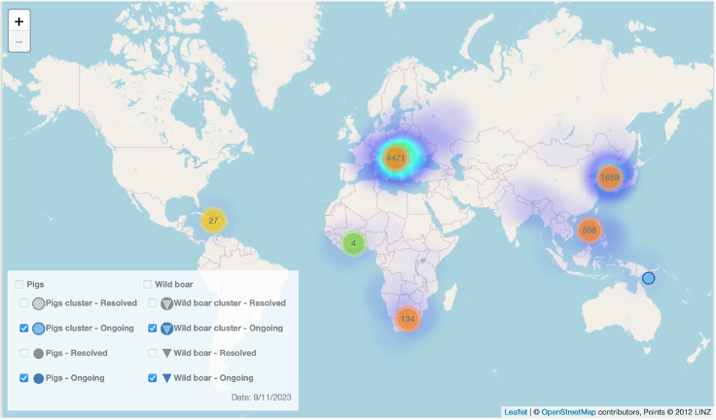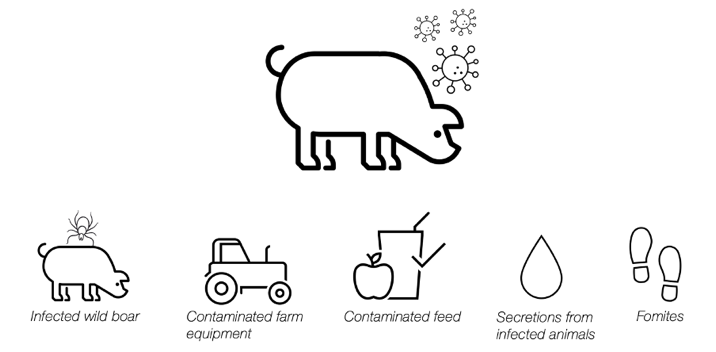October, 2023

Mo Ducker
Senior Scientist
ASF what is African Swine Fever?
African Swine Fever (shortened to ASF) isn’t exactly a house-hold name when talking about infectious diseases. And significant collaborative efforts are required to keep it that way. The ASF virus (ASFv) causes a lethal haemorrhagic fever, mainly affecting farmed pigs. Critically, ASF disease can have a mortality rate close to 100% (1), with no cure or treatment available. Infection control relies on sanitary measures to prevent introduction of the virus into pig farms. Once the virus reaches a farm, the only method to control spread is through “depopulation”, which involves culling of all infected and exposed individuals. Then quarantining entire farms for over 3 months. Despite best efforts, outbreaks continue to spread across the world. Originating in Sub-Saharan Africa, ASF has been identified in 74 countries since 2005 (2), with outbreaks recorded in Africa, The Americas (yet, not mainland USA), Asia and Europe. When introduced to main-land Europe, ASF swept across the continent at a rapid pace. Concerted efforts are needed to prevent the same happening in the USA and other large landmasses.

pig333.com
Interactive map produced by pig333.com using World Organisation for Animal Health data. The map shows ongoing ASF outbreaks as of 11/09/2023. To explore the map, please visit: https://www.pig333.com/asf/
Disease and Spread
Fortunately, ASFv has a near zero chance of zoonosis, so we won’t be hearing about African Swine-But-Also-Human Fever any time soon. However, for pigs that do get infected, the outlook is not so positive. Fever, haemorrhage, and respiratory distress are all symptoms of ASF. So is sudden death. In the two years between 2021 and 2023, over 1.4 million pigs were lost to outbreaks (3). That’s enough pigs to fill over 12,000 London buses. The high level of mortality is due to the severity of disease and the ease of transmission that happens through multiple routes. Something as simple as driving from one farm to another can spread disease. Common practices such as sharing of farm equipment and food can spread disease. Additionally, direct contact between healthy and infected pigs or wild boar, bodily fluids, and bites by carrier ticks are also common means of transmission. Once infection is established, even after all the infected pigs are removed, viral particles remain infectious in the environment for months.

Figure showing transmission routes of ASFv.
Food security
Pork is the most consumed meat in the world. China is the largest producer and consumer of pork, raising more pigs than the EU and US combined (4). In August 2018, ASF was detected in China for the first time. This resulted in a catastrophic outbreak, and the loss of millions of pigs. A conservative estimate of the associated deaths totals 43.5 million pigs (5), 6% of the 694 million pigs slaughtered in China in 2018. The economic loss associated with these figures is over $100 billion, close to 1% of China’s gross domestic product at the time (a measure of a country’s goods and services) (5). Other sources have speculated that 6% does not account for under-reporting, and the true figure is closer to 30-50%. That’s a whopping ¼ of pigs world-wide. It is concerning that ASF has the power to wipe out such a large percentage of a major food source. With food security becoming an increasing issue across the globe, the prevention or eradication of ASF is a priority.
Current vaccination approaches
Similar to how some strains of SARS-CoV-2 cause milder Covid-19 disease than others, this can be true of ASF too. Rather than the close to 100% mortality of acute infection, some ASF virus strains can cause chronic infection with reduced virulence. By looking at some chronically infected pigs that were asymptomatic, attenuated viruses were tested as vaccine candidates. This strategy resulted in two ASF vaccines in Vietnam being licensed this July (6). This is a fantastic start that has the potential to protect many pigs. However, live attenuated vaccines rarely protect against multiple different strains of the virus (making them good for use in one geographical area but not others) and are difficult to manufacture at scale. There is also the more concerning possibility that the virus may regain virulence and cause an outbreak itself. By using our proprietary algorithm, Baseimmune is hard at work developing an exciting alternative: a vaccine antigen without the rest of the virus. The antigen includes regions from across the ASF virus genome, protecting against different strains found in different locations world-wide, and future variants… watch this space!
References:
- “OIE Technical Disease Card: African swine fever”, 2019, World Organisation for Animal Health
- “ASF evolution since 2005”, World Organisation for Animal Health. https://www.woah.org/en/disease/african-swine-fever
- “African swine fever (ASF) – Situation report 37”, 2023, World Organisation for Animal Health
- “Global pork production 2022 & 2023, by country”. Statista. https://www.statista.com/statistics/273232/net-pork-production-worldwide-by-country/
- You, S., Liu, T., Zhang, M. et al. African swine fever outbreaks in China led to gross domestic product and economic losses. Nat Food 2, 802–808 (2021). https://doi.org/10.1038/s43016-021-00362-1
- “Swine Disease Global Surveillance Report”, 2023, Swine Health Information Centre and University of Minnesota
Main photo credit: - Oklahoma AG
Follow Us @baseimmune
ASF ∙ VACCINE ∙ SCIENCE




